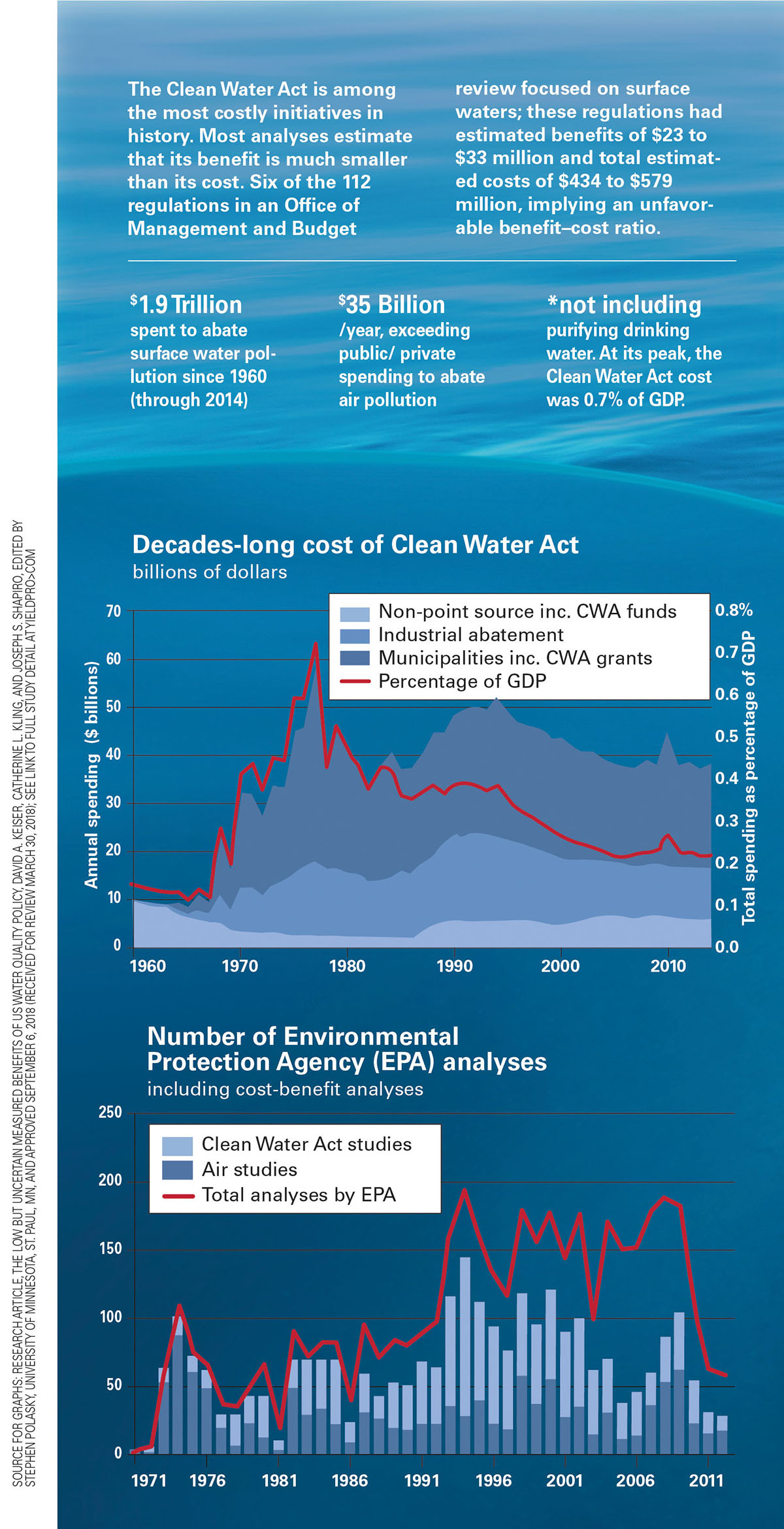The Clean Water Act turns 50 this fall—and like most things at age 50, it no longer functions like it once did.
Congress passed the Clean Water Act (CWA) on October 18, 1972, to combat pollution in the country’s more-than-25,000 miles of waterways. But 50 years later, the government isn’t enforcing the CWA as a water-quality statute. Instead, the government treats it like a federal land use code, under which countless Americans have had their livelihoods and property rights destroyed.
In fact, the CWA presents a classic tale of an unmitigated federal agency power grab—and it’s time to reevaluate the 50-year-old law.
The plain text of the CWA authorizes the Environmental Protection Agency and the Army Corps of Engineers to administer a permitting scheme to regulate “discharges” into “navigable waters,” defined as “waters of the United States.” That term “navigable waters” was designed by Congress to represent the jurisdictional outer-bound of the agencies’ regulatory authority.
So far, so good. We have a federal statute granting authority to a federal agency. And—as is required by the Constitution’s separation of powers, which locates policymaking authority in Congress and not executive branch agencies—we have a statutory term which properly limits that grant of authority. If the discharge goes into a “navigable water” as defined in the CWA, it may be regulated by the federal government. If it goes into a non-navigable water or non-water feature, regulation is left to the states.
However, beginning in the mid-1970s, the EPA and the Corps began interpreting the term “navigable waters,” not as a limitation on their authority but rather as an all-encompassing grant of regulatory authority. By 1986, the agencies seemed to believe they could regulate activities in and around every ditch, wetland, pool, or puddle—no matter how ephemeral.
As a result, within 20 years of its passage—and with no significant amendment to its key terms—the CWA had evolved from a statute designed to combat water pollution to a federal land use code.
Compliance was not a mere box to check: A study conducted in 2002 concluded that on average, a Clean Water Act “dredge and fill permit” takes two years to obtain and costs more than $250,000 in consulting costs. Compounding matters, the agencies have not been afraid to impose ruinous civil and even criminal penalties, to enforce their land-is-waters approach to the Act.
This all came to a head in 2006, when PLF secured a victory in Rapanos v. United States. In that case, a majority of the Supreme Court rebuked the agencies and ruled that the term “navigable waters” could not be read as a limitless grant of authority to regulate every piece of soggy land in the United States. Unfortunately, the Supreme Court could not reach a consensus on the appropriate test for agency authority.
Justice Antonin Scalia, writing for a plurality of four Justices, issued a clear and reasonable standard that limited agency regulation to “waters”—understood in the conventional sense of the term. That is, relatively permanent or continuously flowing bodies of water. He also concluded that wetlands—which by definition are not “waters”—must have a continuous surface water connection to a true “water” in order to be regulated.
Justice Anthony Kennedy, on the other hand, came up with a “significant nexus” test: A wetland need only have a (vaguely defined) significant nexus to some downstream water to fall under the scope of the Clean Water Act. Justice Kennedy’s test is framed as a limitation on agency authority. But from the beginning, the agencies have effectively treated it as merely providing a name for their prior “land-is-waters” approach. Indeed, every administration—except for the Trump administration—has relied upon Justice Kennedy’s significant nexus test to continue ratcheting up agency authority over private land.
With each turn of that ratchet, the American public has suffered. This is borne out by the experience of multiple PLF clients.
Take Jack LaPant. In 2016, Jack, a farmer in Northern California, was hauled into court and threatened with potentially millions of dollars in civil penalties. His only infraction? Plowing a previously cultivated field to plant a winter wheat crop. Because that dry field occasionally contained shallow pools of water, the government asserted that Jack needed a federal permit. Faced with the unlimited legal resources of the federal government, Jack settled that lawsuit to avoid potentially catastrophic financial harm.
Even more harrowing is the tale of Joe Robertson, a Navy veteran living in an area of Montana increasingly prone to destructive wildfire. Joe dug several small ponds around a nameless, foot-wide, foot-deep channel. His intention? To ensure a more reliable water supply so he could protect his home from wildfire. Because the EPA considered that tiny channel to be a “navigable water,” he was criminally prosecuted.
At age 77, he was sent to prison for 18 months and fined $130,000. His conviction was later vacated by the Supreme Court, but by then, sadly, Joe had passed away.
Or take Chantell and Michael Sackett, a couple who in 2007 started to build a single-family home on their 0.6-acre lot in a residential subdivision near Priest Lake, Idaho. Shortly after breaking ground, they were approached by federal officials, who asserted that their lot contained wetlands which could be regulated as “navigable” waters. They were subsequently threatened with fines of tens of thousands of dollars per day and have spent the past 15 years in court fighting the EPA for the right to build their home.
A couple should not need to spend 15 years in litigation just to build a single-family home. Senior citizens should not be imprisoned for performing routine maintenance to protect their homes from wildfire. And plowing a dry field should not lead a farmer to the brink of financial ruin.
Clearly, it is time to reevaluate the Clean Water Act and restore the limitations on agency authority imposed by Congress in 1972. Thankfully the Supreme Court has an opportunity to do so this fall—right around the same time the CWA turns 50.
On October 3, the Supreme Court will hear argument in Sackett v. EPA. The Sacketts’ case affords the Court an opportunity to adopt a test for Clean Water Act jurisdiction that would properly limit federal authority. The Supreme Court should rule in the Sacketts’ favor—and end the EPA’s five-decade power grab.

Source Charles Yates, Pacific Legal Foundation
















